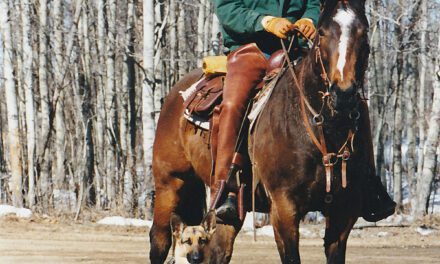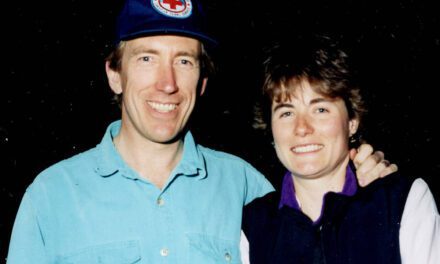Thank you to the Whyte Museum of the Canadian Rockies for granting permission to the Park Warden Service Alumni to post this interview on our website.
This Oral History interview was funded in part by a research grant received in 2019 from the Government of Alberta through the Alberta Historical Resources Foundation.
Park Warden Alumni Society of Alberta
Oral History Phase 9, 2019
In person interview with Al McDonald
Date/time: November 25th, 2019 @ 1030 Banff
Interviewed by Monique Hunkeler
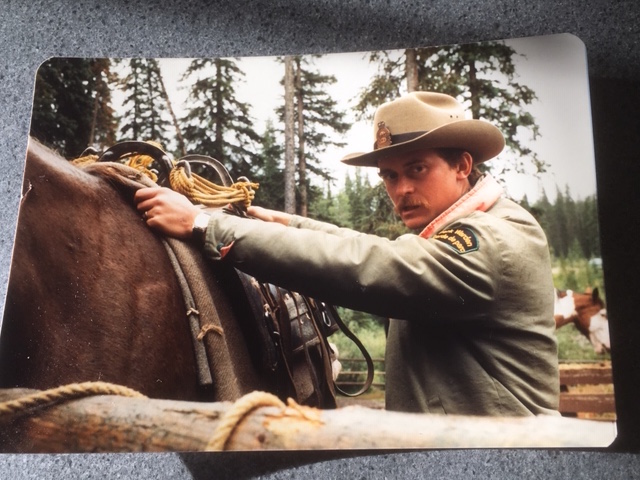
Al in Willow Creek District 1979
Place and date of birth? Born March 4th 1951 in Ottawa Ontario
MH: Where did you grow up? I grew up in Ottawa and came out to Banff in 1969 as an 18-year-old, looking for adventure and skiing and all that good stuff and kind of fell in love with the mountains. I started as a bellhop at the Banff Springs Hotel. It was the first year the hotel was open in the winter and I had applied for the job before coming west and got the job. So I came out here with a job in hand. Worked only a few months at BSH and then went to Sunshine and worked as a cook’s helper in the kitchen, skied lots and after that was at Wapta Lodge, Lake Louise Ski Area and that spring I got the job in Rogers Pass (1971). I went back to school in 1975-1977 and when I graduated, I got my first job in Elk Island National Park.
MH: How did you become involved in the Warden Service? Which national park did you start working in?
AM: What happened was I got a job in Rogers Pass as an Avalanche Technician and that was my first Mountain job beside being a ski bum at Lake Louise and Sunshine. So I worked there for 2-3 winters and was working with Gordie Peyto and all the legendary Park Wardens and I thought, “Wow this is a pretty cool job, how do I get this job?” This was the time when a high school diploma didn’t quite cut it anymore and you needed either university or college diploma. So I looked around and decided to go to Selkirk College in the Kootenays and Gerry Israelson and I were classmates. I got my two-year Wildland Recreation Diploma and applied and was interviewed by Jimmy Sime of all people and Gerry and I both got on the list. In 1977, I got on in Elk Island National Park. And Gerry and I both ended up in Elk Island.
MH: What made you want to join the Warden Service? 0407:
AM: Again I had seen how much fun they were having in Rogers Pass so I thought I want to have that much fun and I wanted to be in the mountains. Ironically I ended up in Elk Island which is so flat. I pined for the mountains but I did learn how to ride horses in Elk Island. I was a city boy and had never ridden a horse in my life. Fred Dickson, was an old cowboy warden there along with Bill Walburger. They taught me everything I needed to know about horses so it was a great start.
MH: What different parks did you work in? How did they compare? Do you have a favourite? 0500:
AM: After that I went to Jasper for 8 years, Jasper to Lake Louise, Lake Louise to Banff in 1990 and then got a job in Kootenay-Yoho-Lake Louise (KYLL) as Operations Manager for a few years and after KYLL, Backcountry Manager in Banff and I retired from that job.
The Parks were all different and all interesting. I think Jasper has a special place in my heart because the backcountry there is so amazing and so big. I was fortunate there because my first job was a backcountry district warden (Willow Creek) and then I moved to Sunwapta but sometime between that period, I got a job as the Boundary Coordinator which was just the best job because you just travelled all summer, went from district to district and worked with each of the district wardens. In Jasper at that time, there were 6 districts, with a Seasonal Warden in each one. My job was to travel with them, mentor them, whatever else, cabin repairs, clearing trails, wildlife surveys. So that was great because I got to see the entire Park. There were 44 cabins in Jasper back in the day and I got to visit every single one except for Whirlpool. When I was the North Boundary Coordinator, my job was to travel from Willow Creek to Blue Creek to Smokey and back and forth and the only people were horse outfitters. In those days there were lots of outfitters but you might run into the odd hiker but that was it. Pretty quiet.
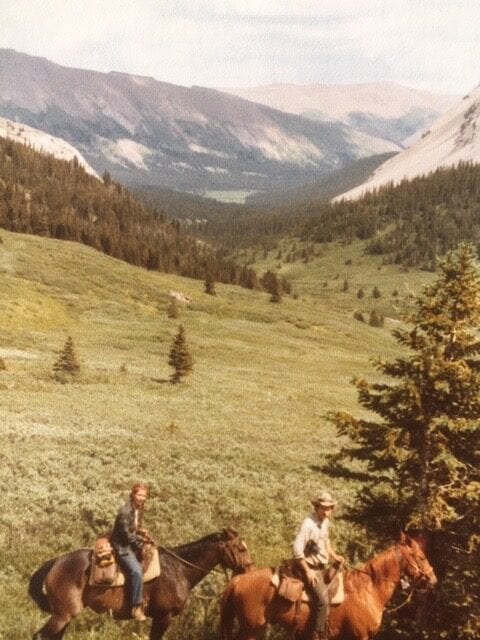
Bernadette and Al Willow Creek District 1979
MH: What were some of your main responsibilities over the years? 0840:
AM: The backcountry of course and when I moved to Sunwapta in 1979, it was kind of the last of the generalized frontcountry warden stations. There were four of us stationed there and the main responsibilities were looking after the Columbia Icefields area, all the rescue work, bear work at the campgrounds: Jonas Creek, Wilcox, Honeymoon and we also had that Brazeau loop with 4-5 backcountry cabins that we were responsible for. We had horses and a corral. It was kind of like the old Saskatchewan Crossing but a bigger operation. I worked with Al Stendie, Darro Stinson, Tom Davidson, a whole bunch of guys moved through.
In KYLL, when that was formed, my first managerial position, I was the Frontcountry Manager, in charge of Yoho, Lake Louise and Kootenay guys. I did that for about 3 years and moved from there back to Banff as Backcountry Manager, the dream job.
MH: What did you like / dislike about being a warden? 1045:
AM: I just loved being out in the mountains. It was an amazing job when you think about it, that you could be outside every day. Not when I became a manager mind you but every day you were just outside. There was never any time in the office in those days. Especially the Sunwapta scene, you’d go climbing, hiking, skiing, horseback riding. Always out.
AM: I didn’t like the politics and I didn’t particularly like that whole era with the grievance about the firearms came in. Of course I was in a managerial role so it was tricky, being a manager, stickhandling the politics. Some guys were adamant that they needed guns, other guys didn’t want them and you had your own feelings about it. It was a complicated, weird period and I didn’t like that very much. That was my least favourite part of my career.
MH: What were some of your more memorable events as a Warden? 1220:
AM: There were so many things, stuff happens all the time. One of the biggest events in my career was the event I call the Point Camp Grizzly. It was an event involving a grizzly bear that I had to shoot. It was at Point Camp North of Lake Louise in the backcountry, Paul Peyto’s semi-permanent camp. Little Pipestone is the cabin adjacent to the camp. There was this little sub-adult grizzly bear that was marauding all the camp sites in the Skoki, Little Pipe area. Back in those days, there were a lot of hikers in the Skoki Area. Every time this bear would show up in the camp, he would get aggressive and push people away from their food. Quite often they would have to climb trees to get away from this bear. He was a nasty little piece of work, but he kept getting rewards. So it was a huge problem. Basically the whole Skoki region had to be closed. We had Rick Kunelius and all the wildlife Wardens from Banff came in and set traps all over the place but we couldn’t get this bear. It kept evading the traps and raising hell. So one night I was working frontcountry Duty Warden in Lake Louise and it was kind of a slow night so I said to Dale Loewen my boss, “Why don’t I ride into Point Camp and see what is going on.” It was a 12 km ride. So I rode in there and had my rifle with me but before I left, Dale was at the barn when I was saddling up and I asked him, ‘What do I do if I see the bear? And he said, ‘”Just shoot the damn thing.” I was thinking, that’s not what we are supposed to do in this day and age but I thought, ‘Whatever.” – and I ride off into the sunset. Sure enough, when I get to camp, the damn bear shows up and I was so surprised. I tied up my horse and walked around inspecting the electrical fence because we thought maybe there was a problem with the fence because the bear kept getting into Paul’s camp, but the fence was fine. Then all of a sudden, there’s the damn bear and he was aggressive. He was behaving like an aggressive dog. The fur was up, he was woofing and bluff charging me. And luckily I had the rifle, but I had to scurry back to the horse and get the rifle out. But I could tell he was kind of puzzled because he was used to people either running away or climbing trees and I wasn’t doing any of that. I was basically standing my ground. So I got the rifle, got a nice rest with the rifle, the horse was jumping round and fidgeting, but had a good rest and sight and he came at me again and then he stood there, puzzled and he turned and I had a perfect shoulder shot so shot him in the shoulder and he didn’t go down, he ran. And I thought, “Oh my god, I’ve really done it, I’ve shot the bear and he’s run away wounded”. So I followed him, which was really stupid because I was by myself, followed him into the brush, willows and he was laying there dead, I didn’t know that at the time so I reloaded, put another clip into the .308 and bang bang! Bang!…just kept shooting because the adrenalin was pumping. Terry Skjonsberg told me later that the first shot had entered into the heart so that was the killing shot. Bears always run when they were shot but he went down and it turned out to be the right bear, so I didn’t shoot the wrong bear, even though the helicopter pilot at the time (the helicopter came in and we flew the bear out.), Bob Johnson insisted, ”He’s got the wrong bear, the bear looked a lot different than that”. There was quite a foofaraw because the public was up in arms about it all. It was around 1988 or 1989. Gaby Fortin was the Chief Park Warden at the time. That was one of the more scary, memorable things that happened. But there were so many stories.
1900: The rescue stories, of course working at Sunwapta there were lots of interesting rescues. The three years I spent in Lake Louise, I worked quite closely with Clair Israelson and although I wasn’t in Public Safety, I had all the skills so he often brought me into rescue situations. The one I do remember, I was first at Sunwapta around 1980 and I was young and pretty green and there was a young fellow by the name of Tobin Sorenson from the States and he was a very young strong American climber. Famous for doing the North face of the Matterhorn and other routes but we didn’t know him at all. Anyways, he shows up at the Icefields, parks his car at Beauty Creek parking lot and goes in to climb the North face of Mt Alberta all by himself, probably one of the hardest routes in the Rockies. He was overdue (you had to sign out at the Icefields Centre in those days). Bernadette was the supervisor at the Icefields Centre in those days. We went to look for him and I wasn’t an experienced rescue warden yet. Darro Stinson and Tom Davidson were the ‘go to’ guys in Jasper in those days. So anyway, I didn’t expect to get involved but got geared up. The radio was going, dispatch, the helicopter was coming in and it lands at Sunwapta and there is Alfie Burstrom and Ginger, the dog, and that was it. No Darro, no Tom just Alfie and Alfie says, “Jump In”. He didn’t even know my name. I was this young, green newbie living down at Sunwapta. So I jump into the helicopter and of course he’s in the front seat with the pilot and I’m in the back with Ginger and she was an intimidating dog. Big German Shephard, part coyote and she’s drooling all over me. Off we go to look for Tobin Sorenson and this was probably my very first helicopter search that I was ever on. We get up there and it was beautiful in the valley. It was October 2nd, a beautiful fall day. Tobin had picked that sort of frozen period to do this solo which is smart. Anyways we flew up there and we are searching the north face of Mt. Alberta which is so incredible but the most intimidating thing you have ever seen in your life. It’s unbelievable. Anyway flying around and the weather closes in. Garry Forman was the pilot this day and he says, “Guys we are out of here. It’s coming in really fast.” Lo and behold, before we can get back to the valley, the window closed in on us. We had to find a high shoulder (we were at 9500 feet), this kind of ridge to set down and wait out the storm. We were there for hours. The storm was raging around us. The helicopter was getting buffeted around, it was crazy. At one point Alfie, old school kinda guy with a stutter said,”You know, we gotta go down to timber and build a fire”. We were freezing. There was no heat in the helicopter. I’m thinking, “Oh my god, we’re not going anywhere in a white out, we don’t’ even know where we are”. We were somewhere between Mt Alberta and Sunwapta Warden Station. Garry was cold, he only had his pilot coveralls on. I gave him my insulated wind pants and that kinda changed the subject and Alfie forgot the idea of going down to timber. But finally it cleared off and it was getting late (400 pm) and it was time to leave. The problem is the helicopter had been sitting there for hours in the cold wind and Garry wasn’t sure if it would start. He had Alfie go outside, there was a bit of a slope and Alfie could reach the rotors and he helped to get the rotors moving and then Garry could crank it and got it going. He was mumbling over the radio intercom the whole time saying, ‘Yah, I don’t’ know about this. I guess the worst case scenario is we can lift off and if we can’t fly, I guess we’ll just auto rotate down to the valley.’ And I’m sitting in the back going “Oh My God! What have I got myself into?” This is a nightmare I was thinking. It actually worked though. He lifted off, and just dropped like a stone, 4000 feet down into the valley and it was the wildest decent, but he had control. The helicopter was working. He just shot down and down we went and that was the end of the search for Tobin that day. Darro and Tom came the next day and found the body. He had fallen off the face, solo climbing. It was quite a famous incident because he was well known in the world. He was known as one of those hotshot young climbers. That was one of my more memorable Public Safety incidents. One of the first and most memorable. The whole helicopter thing was pretty scary. I don’t even like to fly in helicopters anymore.
MH: Can you tell me about any rescue/wildlife stories that stick out in your memory?
AM: Another interesting one was up in Jasper when a local boy, Rick Black, was trapped in the Arctomys Cave. A big huge bolder crushed him and he died and we had to get him out of there and he was so far down. It was a huge response. Cavers were called in from all over, wardens aren’t cavers, so we had guys coming in from Victoria and Calgary, different caving associations. We had a huge camp set up above the entrance to the cave which is in Mt. Robson Park. Most bizarre thing you’ve ever seen, it was just this little hole and that was the entrance to the cave. It goes down for miles. It used to be the deepest known cave in North America. So we had shifts and I was involved in one 8 hour shift with Pat Sheehan, Marc Ledwidge and I, and down we went, down climbing this incredible cave system for 8 hours and we finally got to the body. At that time, they knew he was dead, it was just a matter of getting him out. It was this incredible process. He was in a slippery, fiberglass toboggan and we were all down there moving this thing through these incredible passages and in places it would drop down like a chimney into the black darkness and you didn’t have a clue what was down there and we weren’t roped up or anything. It was all slimy. So you would get two or three guys standing over the chimney on both sides and the guys would push the toboggan over our backs. And of course you had caving coveralls on but you were all covered in slime and mud and it was the most hideous thing in the world. That was my one and only caving experience and I would never go back into a cave again. It was so gross but we got him out in 2 days. Him and two other 20-something year old Jasper kids decided to go and have a little adventure and he got crushed and died.
3140: And then there was the Albert River mauling which was pretty wild where two hunters were mauled by a sow grizzly and her cubs. Marc Ledwidge Lance Cooper and I went. Flying was horrendous, deep snow, and the helicopter blew up a garbage bag which was the first clue. We came back from that flight because the weather was moving in, this was the recon flight, where we saw the bears and the big bloody mess on the snow and the garbage bag flew up. So we flew to the staging area and all the family and other hunters were there saying, “Oh no bears don’t bother us hunters”. We went back up the next day and again horrible flying weather. Lance was serious but very serious that day. Got Gord Peyto in there and he shot the bear and cubs and then we got Scott Ward in with his dog and we found the first body close to the kill site and the second body was about 200 meters downhill from the site and what we think happened was the bear killed the first guy and chased the second guy down the hill or the bear mortally wounded the second guy and he ran down the slope and succumbed to his injuries. And then of course the bears had their way with the guys and the carcass. It was one of those gross scenes. We were under a lot of pressure because it was in the Province of British Columbia. We were working with Russ Hendry from the province (MOU with the BC Province). He had called us in to help find these guys. It was tricky, different province, different group of people, poor weather.
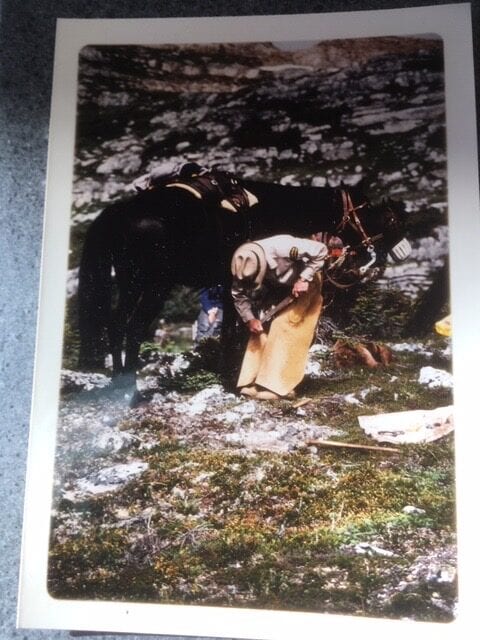
Reshoeing Hardscrabble Pass, Blue Creek District 1979
MH: How did the Warden Service change over the years? 3500:
AM: that’s a really easy question. It’s called the gun guys and then there is everybody else. That’s kind of what happened, the way I see it. I don’t really have much to do with the Warden Service anymore, except the alumni Association stuff but you know, It’s kind of inevitable, the world changes. It’s kind of upsetting in a way that those fantastic days are over but they are it’s just like anything, life goes on; shit happens.
MH: What about the Warden Service was important to you? 3550:
AM: I don’t think there was anything really noble for me. I enjoyed the whole thing and I support National Parks but I didn’t come to work every day thinking I’m going to protect and preserve the Park. I was more of a fun hawk actually, enjoying the camaraderie, the outdoors, horses, skis, climbing, not the helicopters but everything else.
MH: Are there any legends or stories associated with the Warden Service that you can share?
Is there anyone from the Service that stands out in your mind? 3637:
AM: Legendary characters is how I interpreted this question. Tim Auger comes to mind but for me Tim was quite late in my career, but I did work with him directly. At Sunshine I worked under him and for a couple of summers, worked Public Safety with Tim so that was an awesome experience. The other person whom I owe my gratitude to is Brian Wallace. He was the Boundary Coordinator in 1979 when I had my first district in Willow Creek, Jasper. He taught me basically everything I know about horses in the backcountry, safe travel, cabins, cutting logs off trails, maintaining the phone line which they still had that year. He was so good and so patient and nice to be around and work with. We have been friends ever since. He was my mentor. To this day when I think back to 30 years of travelling in the backcountry, what he taught me saved my bacon so many times. Shit happens when you are travelling in the backcountry and what Brian did was ingrain in you that you really had to watch, paying attention to your horses all the time because you never knew what they were going to do. Not that I was paranoid, I just was always watching and I managed to dodge a few near misses as a result. He was one of the top people I worked with.
3935: And the other guy up in Jasper was Willi Pfisterer. Willi was such an amazing traveler, mostly winter traveler, ski mountaineering, not so much in the summer although we did some climbing in the summer. But the trips that we did, the Warden Schools were amazing. I did almost every Icefield in the Jasper Region, all these big wild places. He was such a great guy to travel with. He was the master of winter camping. He spent more nights in tents and snow caves than any man I know. He was probably the Alpine Specialist for 30-35 years and every winter he did multiple Warden schools, all involving camping. In Jasper, there were no huts. There was no such thing as doing the Wapta traverse and staying in Peyto, Balfour and Bow Hut. You winter camped everywhere. He did it until he was 55 or 60 when he retired and he was starting to hurt. He had shingles at one point and a whole bunch of health issues but he was still out there digging snow caves which is pretty impressive. He was kind of a Wardens guy. He enjoyed being with the Wardens even though he wasn’t a warden himself, he was an alpine specialist and a mountain guide from Austria. He just enjoyed being with the guys, and the girls who came along, Diane Volkers, and Kathy Calvert I remember camping on the Resthaven Icefield with Kathy Calvert, we were tent mates and she was as tough and as capable as any of the guys. I think Willi enjoyed that too actually. And to be fair to Peter Fuhrmann, I did some great schools with him too. But I guess maybe I was younger and more into the mountains during the Willi era, but Willi just was a special person to me.
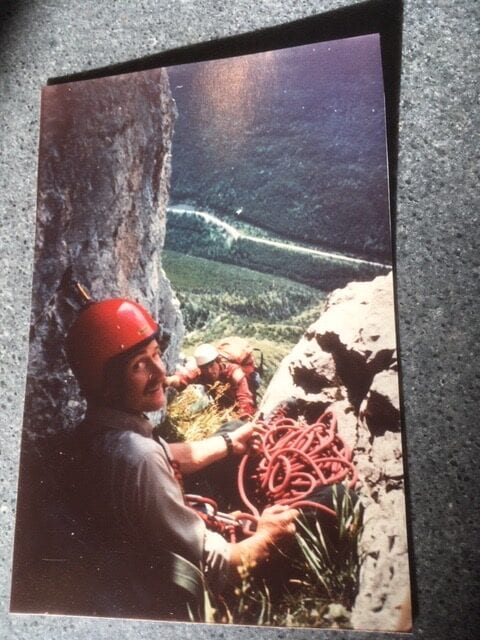
Rock Climbing With Murray Hindle Ashlar Ridge Jasper 1981
MH: Is there anything about the Warden Service, as you knew it, that you would like future generations to know? 4300:
AM: Of course just the whole backcountry thing. I don’t think the backcountry is really well looked after anymore. I think we would all agree about that and I think that’s a shame. Maybe there isn’t a million tourists running around in the backcountry but still it’s important and I worry about the boundary because I really don’t think it’s well looked after. I’m sure the outfitters are going, “Oh Boy, look at this, there’s a nice ram over there that we can get.” And nobody really knows what’s going on out there anymore. I hope that there is some sort of way to improve things but the world has moved on and the young people working in the Warden Office don’t particularly care, or have different priorities. I shouldn’t be so critical because I do go onto the Bison relocation website sometimes and see the girls out there with the horses and stuff and that’s great. They are still using the horses and living at Windy and that kind of thing. But I don’t think anybody is really patrolling the backcountry that I know of. That part of it, I sure know we can improve and I think the Alumni is doing a good job keeping that alive. Sometimes I think we are almost too nostalgic about it all, (the world is moving on and we have to accept that) but at the same time, it’s nice to keep the important parts of the history and especially the really old times when wardens lived in the backcountry with their families. Actually Bernadette lived with me my first summer in Willow Creek and she did lots of other trips with me and she loved it. It was pretty amazing to get paid to do that job.
MH: What made the Warden Service such a unique organization? 4515:
AM: The camaraderie was pretty special because when you’re in these life threatening situations where you are really relying on the other person for your safety. If all hell breaks loose, you knew the other person had your back. I think that’s why so many of the old timers value their relationships so much. That started in the outfit and it continued into their retired lives.

Brazeau Fishing 1982 Al, Tracer and John Niddrie
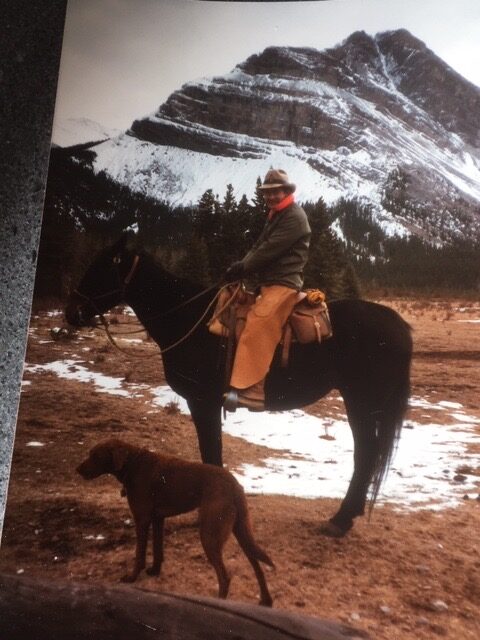
Al and Dog Tracer Cyclone District 1987
MH: Do you have any lasting memories as a Warden? 4635:
AM: I think just the whole backcountry way of life in Jasper was very special. All the cabins, the north boundary was incredible. Blue creek was this legendary old log cabin, well built and sturdy, about two days’ travel from the trailhead and it was wilderness. That is the biggest thing about Jasper backcountry, you felt so remote. It was real Wilderness. We did a lot of horse assisted camping trips where you went out into the Wilmore Wilderness and back over Hardscrabble Pass and all very wild areas.
MH: Do you ever miss being a Warden?
AM: I feel like I’ve moved on. We have our property in Penticton and spend the winters here in Banff and see lots of colleagues from before. It’s nice to have that connection still. We’re primarily here in winters and Penticton in summer. By virtue of the fact that we have a vineyard, garden, and a home, small farm so my energies have been funneled more into that direction and I don’t worry about what is going on with Parks anymore. Although I am interested and am quite fascinated with the Bison reintroduction process. Am I convinced it’s going to work? Well so far so good. It’ll be interesting to see what happens, maybe prove all us nay-sayers wrong. They are serious animals. When I worked in Elk Island, we had two wardens gored by bison. Fred Dickson and Rod Wallace were gored. Fred was working the chutes and he swung the gate open so the the bull could come into a squeeze, but instead, the bull came around the gate and gored him, hooks him and flings him out onto the ground. Those bison are aggressive. The cows can be aggressive too. Rod Wallace has a bison story too. Either him or his horse were gored. I don’t know what’s going to happen there. Luckily in the Panther area, there isn’t that much traffic anymore.
MH: Do you have any photos of yourself as a warden that you would like to donate? Artifacts? 4330:
AM: we took pics of his photos so I have a list
MH: What year did you retire? 5230:
AM: 2006
MH: What do you enjoy doing in retirement? 5235:
AM: Of course the stuff down in BC. This winter already, we have been out 5 times backcountry skiing. We do a lot of skiing, no ice climbing anymore. We are very keen rock climbers, usually 30 days per summer. One of the reasons we chose Penticton was because of the Skaha bluffs which is great rock climbing. Multi pitch routes around Banff as well but no alpine climbing anymore, just sport climbing.
MH: Is there anything I haven’t asked you that you think I should know about the Warden Service? 5300:
AM: Not really, I think we pretty much covered it.
MH: Anyone else to interview?
AM: No other suggestions.
MH: Any final comments?
AM: Nope
This interview was conducted by Monique Hunkeler
Monique Hunkeler first started working with Parks Canada in 1989 as Secretary to Banff National Park Finance Manager. She moved into a position as Dispatcher for the Banff Park Warden Service and later worked within Banff National Park and Town of Banff’s IT departments. She is experienced with the interviewing, transcription and archiving process the Park Warden Service Alumni Society.


